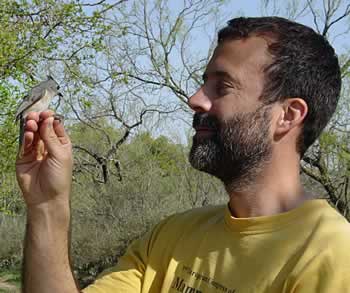Kenneth Schmidt
Email: kenneth.schmidt@ttu.edu
Phone: 1(806) 834-6763
- Ph.D., Ecology and Evolutionary Biology, University of Illinois at Chicago (1997)
- B.S., Biology, University of Illinois at Chicago (1992)

Research Interests
Most recently my research interests have centered on The Ecology of Information –
defined as the study of how organisms acquire information to manage their daily lives
of finding food, avoiding predators, selecting habitats, etc., and its significance
for populations, communities, and ecosystems. A passage from Smith (1977:193) captures
the essence of information in ecology as “… an abstract property of events and entities
that makes their characteristics predictable to individuals…(It) enables …individuals
to make choices, to select their activities…appropriately for their needs and opportunities”.
The Ecology of Information is an overarching theme of several current research projects,
including:
Eavesdropping and predation risk - do heterospecifics (including birds and mammals)
use avian alarm calls to adjust their perception of predation risk and are their important
fitness consequences?
Settlement and nest-site decisions – how do prey (e.g., breeding songbirds) use information
do locate high quality (e.g., low predator) sites? We are exploring this empirically
by manipulating predator vocalizations to determine if birds use these as a proximate
cue to avoid their nest predators in time and space. Theoretically, Dr. Rich Straus
(TTU) and I have built a Matlab-based population simulation model to explore how prey
settlement strategies influence prey density, growth rate, stability, and persistence.
Eavesdropping and cognitive abilities of caching in tree squirrels. This work investigates
caching-pilfering systems, such as blue jays
and tree squirrels, as information networks.
Selected Publications
- Schmidt, K. A. and R. S. Ostfeld. Numerical and behavioral effects within a pulse-driven system: Consequences for direct and indirect interactions among shared prey. Ecology. In press.
- Schmidt, K. A., R. S. Ostfeld, and K. N. Smyth. 2006. Spatial heterogeneity in predator activity, nest survivorship, and nest-site selection in two forest thrushes. Oecologia 148:22-29.
- Schmidt, K. A. 2006. Non-additivity among multiple cues of predation risk: A behaviorally driven trophic cascade between owls and songbirds. Oikos 113:82-90.
- Schmidt, K. A. 2004. Site-fidelity in temporally correlated environments enhances population persistence. Ecology Letters 7:176-184.
- Schmidt, K. A. and R. S. Ostfeld. 2003. Mice in space: space use predicts the interaction between mice and songbirds. Ecology 84:3276-3283.
- Schmidt, K. A. 2003. Linking frequencies of resource pulses in oak forests to long-term rates in the Veery (Catharus fusescens). Oikos 103:548-558.
- Schmidt, K. A. Raccoon populations and declines in Illinois' songbirds. 2003. Conservation Biology 17:1141-1150.
- Schmidt K. A., J. R. Goheen, and R. Naumann. 2001. Incidental nest predation in songbirds: using behavioral indicators to determine ecological processes and scales. Ecology 82:2937-2947.
- Schmidt, K. A. 1999. Foraging theory as a conceptual framework for studying nest predation. Oikos 85:151-160.
- Schmidt, K. A., and C. J. Whelan. 1998. Predator-mediated interactions between guilds of nesting songbirds: experimental and observational evidence. American Naturalist 152:393-402.
- Schmidt, K. A. and J. S. Brown. 1996. Patch assessment in fox squirrels: the role of resource density, patch size, and boundaries. American Naturalist 147:360-380.
Department of Biological Sciences
-
Address
Department of Biological Sciences, Texas Tech University, Box 43131 Lubbock, TX 79409 -
Phone
806.742.2715 -
Email
biology@ttu.edu
